Back pain
What causes it?
Back pain is very common and can develop without any clear injury. Contributing factors can include:
- sitting for long periods and a sedentary lifestyle
- lifting or twisting awkwardly
- sudden changes in activity or exercise levels
- muscle tightness or weakness
- emotional stress and tension
- poor metabolic health, for example, suffering from diabetes or obesity
What can affect it?
- Prolonged inactivity can make pain worse.
- Anxiety or fear of movement may cause people to move less, delaying recovery.
- Stress can increase muscle tension and sensitivity.
Management tips
- Keep gently active, avoid bed rest.
- Use warmth (like a hot water bottle or heat pack) to relax tight muscles.
- Change positions often if sitting or standing for long periods.
Exercises to try
Cat-Cow stretch
Start on hands and knees. Arch your back gently upward (like a stretching cat), then slowly lower your back and lift your head and tailbone (cow position). Move smoothly between these two positions 10 to 15 times.
Knee rolls
Lie on your back with knees bent. Gently roll your knees to one side, keeping your shoulders on the bed and floor. Then roll your knees to the opposite side. Repeat 10 to 15 times.
10 Back Facts
1. Long lasting low back pain can be scary but it’s rarely dangerous
Long lasting back pain can be distressing and disabling but its rarely life threatening and you are very unlikely to end up in a wheelchair.
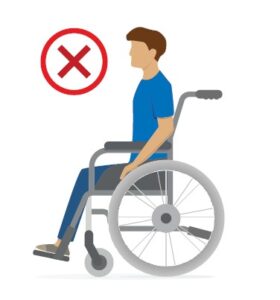
2. Getting older is not the cause of low back pain
Although it’s a widespread belief and concern that getting older causes or worsens back pain, research does not support this, and evidence based treatment can help at any age.
3. Long lasting back pain is rarely associated with serious tissue damage
Backs are strong. If you have had an injury, tissue healing occurs within 3 months so if pain persists beyond this time it usually means there are other contributing factors. A lot of back pain begins with no injury or with simple everyday movement. These occasions may be linked with stress tension fatigue inactivity or unaccustomed activity which makes the back more sensitive to movement and loading.
4. Scans rarely show the cause of low back pain
Scans are only helpful in a minority of people. Lots of scary sounding things can be reported on scans such as disc bulges, degeneration, protrusions, arthritis etc. Unfortunately, the reports don’t say that these findings are very common in people without back pain and that they don’t predict how much pain you feel or how disabled you are. Scans can also change and most disc prolapses shrink over time.
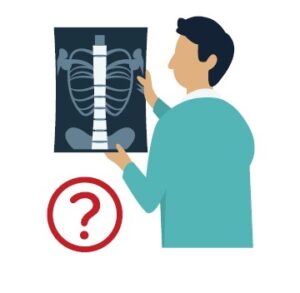
5. Pain with exercise and movement doesn’t mean you are doing harm
when pain persists, it is common that the spine and the surrounding muscles become really sensitive to the touch and movement. The pain you feel during movement and activities reflects how sensitive your structures are, not how damaged you are. So, it’s safe and normal to feel some pain when you start to move and exercise. This usually settles down with time as you get more active. In fact, exercise and movements are one of the most effective ways to help treat back pain.
6. Back pain is not caused by poor posture
How we sit, stand and bend does not cause the back pain even though these activities may be painful. A variety of postures are healthy for the back. It is safe to relax during everyday tasks such as sitting, bending and lifting with a round back, in fact it’s more efficient.
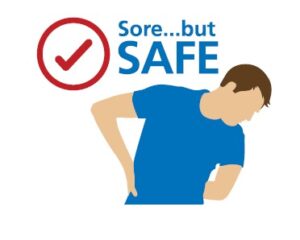
7. Back pain is not caused by a ‘weak core’
Weak ‘core’ muscles do not cause back pain, in fact people with back pain often tense their core muscles as a protective response. This is like clenching your fist after you’ve sprained your wrist. Being strong is important when you need the muscles to switch on, but being tense all the time isn’t helpful. Learning to relax the ‘core’ muscles during everyday tasks can be helpful.
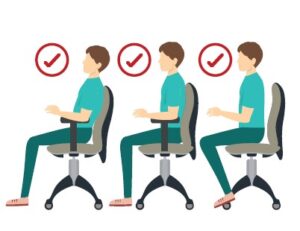
8. Backs do not wear out with everyday loading and bending
The same way lifting weights makes muscles stronger, moving and loading make the back stronger and healthier. So, activities like running, twisting, bending and lifting are safe if you start gradually and practise regularly.
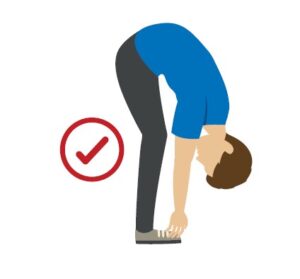
9. Pain flare-ups do not mean you’re damaging yourself
Whilst pain flare-ups can be very painful and scary, They are not usually related to tissue damage. The common triggers are things like sleep, stress, tension, worries, low mood, inactivity or unaccustomed activity. Controlling these factors can help prevent exacerbations and if you have a pain flare-up instead of treating it like an injury, try to stay calm relax and keep moving.
10. Injections chroma surgery and strong opioids usually aren’t a cure
Spine injections, surgery and strong drugs like opioids aren’t very effective for persistent back pain in the long term. They come with risks and can have unhelpful side effects. Finding low risks ways to put you in control of your pain is the key.
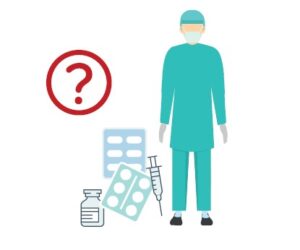
Patient information
10 dos and don'ts for persistent low back pain
10 dos and don'ts for persistent low back pain
Do’s
1. Know that your pain is real
Long-lasting pain is very complex and often not related to a specific injury or damage. This can lead to people feeling that they have not been believed. Similar to other long-lasting conditions like heart disease or diabetes there are many factors which will influence pain. These include things like your activity levels and fitness, general health, sleep quality, mental wellbeing and social functioning.
Importantly, your pain is real regardless of what factors might be involved.
2. Stay active
There is no best exercise for people with long-lasting low back problems (low back pain and (or) low back related leg pain) so choose activities which you enjoy.
The important message is that there is no amount of exercise that is too little. While more is better, a little goes a long way. Over time, regular exercise can help to control your pain as well as improve sleep and mental wellbeing. To make activities more social, consider getting involved in community initiatives such as a local walking group or a parkrun.
3. Sit and move in a variety of ways
A variety of postures are healthy for the back.
It is safe to relax during everyday tasks such as sitting, bending and lifting with a round back if its tolerated. Common warnings to protect the spine are not evidence-informed and can lead to fear.
4. Focus on meaningful life activities
Low back problems can be all consuming.
It can be difficult to focus on other things. Rather than simply trying to reduce pain, focus on activities that bring value to your life. This might include things like going for a walk on the beach, playing with grandchildren, going for a meal with a friend or returning to work.
It is important to realise that it is possible to live a meaningful life while still having pain.
When we use all our resources to try and get rid of pain we have little left for anything else.
Give yourself priority over your pain.
5. Maintain your social relationships
Many people with low back problems feel isolated.
They stop going out with friends, they are unable to work. Feeling lonely can have a negative effect on your mood, sleep and activity levels and can therefore worsen your pain in the long term. Seek out and nurture relationships that are important to you. Think about joining a group or a class in line with your hobbies. Talk openly with your family, friends and employers about your issues and worries.
You do not need to ‘hide’ your pain and don’t compare yourself to others.
Don’ts
1. Blame yourself or ‘fight’ your pain
Pain is not a sign of weakness. Pain can affect people of all ages.
It is easy to get trapped in a vicious cycle whereby attempts to ‘fight’ the pain lead to flare ups. Regular flare ups are associated with lower levels of activity, lower mood, disturbed sleep, frustration and more reliance on medications. A better approach is to reflect on what you can control. Things like your attitude and consistency to exercise over time. By sticking to your plan in a flexible way you can work towards achieving goals in a gradual and steady manner.
Reward yourself for taking positive steps even when they might not always be successful.
2. Assume long-lasting pain always means damage
Think of spraining your ankle – the pain is helpful in the short term so you don’t jump or run on it too soon and worsen the injury.
Given sufficient time and a graded approach to movement, tissues heal and pain resolves. Issues arise when pain persists beyond the expected tissue healing time. Your body can protect you from certain movements or activities even when the tissues of your low back (muscles, ligaments, joints) no longer require it.
Understanding that you can be sore but safe to move is empowering and can help reduce fear and pain intensity in the long term.
3. Rush or panic if you flare up
Peoples journey with pain is often full of ups and downs.
People typically describe these as ‘good’ and ‘bad’ days. This is quite normal. Rather than seeing pain flare ups as a setback, they are often a useful time to reflect on situations and identify potential ‘triggers’, did you have a bad night’s sleep?, perhaps you did more activity than usual?, was work especially stressful? The point is that flare ups can be seen as a learning opportunity.
It is important to develop an array of approaches (often with a health professional) to help manage flare ups. These may include things like activity management, improving sleep and relaxation. Discussions around acceptance may be helpful for some.
4. Believe everything you hear or read
When people are in pain, it is very understandable that they will ‘try anything’.
On a daily basis we hear many claims in the media and on the internet about the best treatments for people with pain. Often these claims are not backed up by any research evidence and instead rely on “testimonials”. At best, some of these untested treatments will be a waste of money; at worst, they may be harmful depending on the type of treatment offered. Usually, there is no simple solution for a complex problem so be wary of anyone offering a quick fix.
Discuss your options with a health professional who is familiar with the best evidence on how to help people with low back problems. This will help avoid unnecessary or potentially wasteful treatments that ultimately hamper your recovery.
5. Rely on scans to tell the whole story
Scans such as X-rays, MRIs or CTs are useful in a small number of people.
They are especially helpful when we suspect a person’s low back problem is due to a serious medical condition or for surgical planning. Thankfully, these conditions are rare and an assessment with your specialist or physiotherapist will help determine if you require a scan. For the majority of people, scans are often unnecessary and do not influence treatment plans. These days, scans are so detailed that they show lots of changes even in people without pain. For example, 40% of people over the age of 30 and 50% of people over the age of 40 have lumbar spine disc bulges on MRI. So, it’s important that we don’t always assume that what we see on the scan is relevant for that individual. It often isn’t as scary as it sounds.
Posture facts
Posture facts
1. There is no ‘correct’ posture
Despite common posture beliefs, there is no strong evidence that one optimal posture exists or that avoiding ‘incorrect’ postures will prevent low back pain.
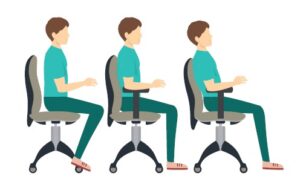
2. Differences in posture are a fact of life
There are natural variations in spinal curvatures and there is no single spinal curvature strongly associated with pain. Pain should not be attributed to relatively ‘normal’ variations.
3. Posture reflects beliefs and moods
Posture can offer insights into a person’s emotions, thoughts and body image. Some postures are adopted as a protective strategy and may reflect concerns regarding body vulnerability. Understanding the reasons behind preferred postures can be helpful.
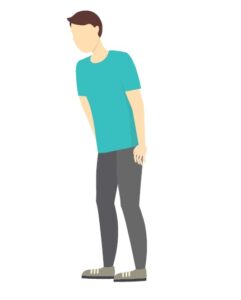
3. It is safe to adopt more comfortable postures
Comfortable postures vary between individuals. Exploring different postures, including those frequently avoided, and changing habitual postures may provide symptomatic relief.
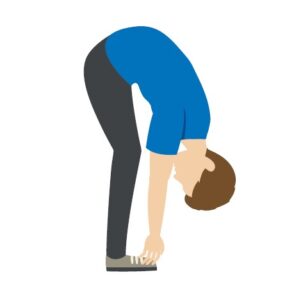
4. The spine is robust and can be trusted
The spine is a robust, adaptable structure, capable of safely moving and loading in a variety of postures. Common warnings to protect the spine are not evidence-informed and can lead to fear.
5. Sitting is not dangerous
Sitting down for more than 30 mins in one position is not dangerous. However, moving and changing positions can be helpful, and being physically active is important for your health.
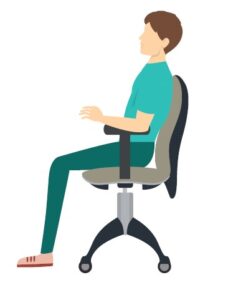
6. One size does not fit all
Postural and movement screening does not prevent pain in the workplace. Preferred lifting styles are influenced by the naturally varying spinal curvatures and advice to adopt a specific posture or to brace the core is not evidence based.
Video resources
Video resources


